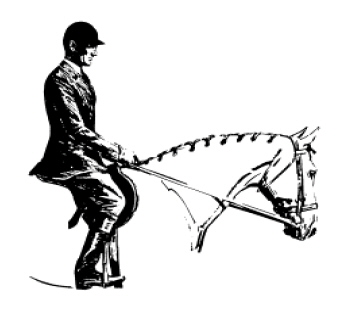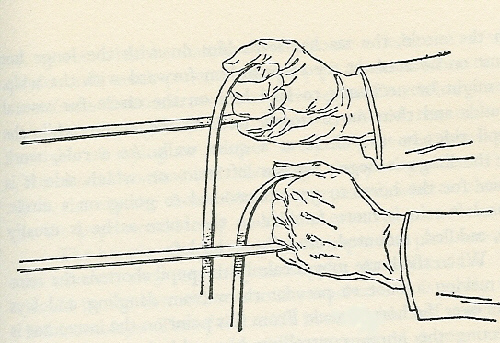IMEHA (International Model Equine Hobbyists Association) was an online photo showing site that existing until 2018. Included on the site were these guidebooks for judging and showing model horses in Performance classes. MEPSA has obtained permission to share the info contained in the guides.
Scoring :: Point Deducts :: Tack :: Set-Up Options :: Photo Examples
Fox hunting is an activity involving the tracking, chase, and sometimes killing of a fox, traditionally a red fox, by trained foxhounds or other scent hounds, and a group of followers led by a master of foxhounds, who follow the hounds on foot or on horseback.
Fox hunting originated in its current form in the United Kingdom in the 16th century, but is practiced all over the world, including Australia, Canada, France, Ireland, Italy, Russia, and the United States. In Australia, the term also refers to the hunting of foxes with firearms similar to spotlighting or deer hunting.
Attire for Formal Foxhunting
*Gentlemen With Colors*
Cap: Blue or black hunting cap with ribbons up is accepted. Top hat preferred.
Coat: Scarlet with brass Oak Ridge buttons. Collars will have a color on them that represents the color of the hunt that awarded them the colors. Any color is accepted. Two large brass buttons in the back. Two small buttons on each sleeve. Gentlemen may also wear scarlet or black swallowtail. A black swallow tail is rarely seen on gentlemen in the hunt field but is stunningly handsome. A gentleman wears the black hunt button but no colors on the collar. This also applies to a gentleman in a black frock coat. He may wear the hunt buttons in black, no colors on collar.
Vest: (optional) Canary or white with brass buttons.
Breeches: White only.
Boots: Black leather with tan colored tops.
Gloves: White string; tan or yellow leather.
Stock: White, properly tied with horizontal gold stock pin. May also be navy blue silk with small, white pin dots or sky blue silk.
Spurs: (optional) Blunt.
Whip: Hunting crop with thong and cord snap. Properly carried but never used unless asked.
*Gentlemen Without Colors*
Cap: Blue or black hunting cap. Black bowler. Ribbons up.
Coat: Black or deepest navy.
Collar: Black.
Vest: (optional) Canary or white with brass buttons.
Breeches: Buff or canary.
Boots: Black, no tops.
*Ladies With Colors*
Cap: Blue or black hunting cap with ribbons up. Black bowler with hairnet. Top hat with shadbelly.
Coat: Black with black Oak Ridge buttons with Collars that have a color on them that represents the color of the hunt that awarded them the colors. Any color is accepted. Two large black buttons on back. Two small buttons on each sleeve.
Vest: (optional) Canary or white with brass buttons.
Breeches: Buff or canary.
Boots: Black leather with black patent tops.
Gloves: White string: tan or yellow leather.
Stock: White, properly tied with horizontal gold stock pin.
Spurs: (optional) Blunt.
Whips: Hunting crop with thong and cord snap. Properly carried but never used unless asked.
*Ladies Without Colors*
Cap: Blue or black hunting caps. Black bowler with hairnet.
Coat: Black or Deepest Navy.
Collar: Black.
Buttons: Black
Vest: (optional) Canary or white with brass buttons.
Breeches: Buff or canary.
Boots: Black, no tops. Also called butcher boots.
Informal Hunting Attire
Hat: Blue, brown or black hunting cap. Black bowler Ladies wear hairnet.
Coat: Green or tweed jacket.
Shirt: Riding shirt with tie. Plain shirt with tie or ascot.
Breeches: Buff or canary.
Boots: Black or brown. No tops.
Junior Rider’s Attire
Junior riders may wear informal attire and leggings. Tricorn hat acceptable on a junior.
During the Hunt
Courtesy in the Field
Those awarded colors always ride up front, followed by other first flight riders. Grooms ride to the rear. Hilltoppers ride with the Hilltoppers’ Master. If a Hilltopper wishes to join the First Flight she or he must ask the Hilltopper Masters’ permission.
Juniors may ride wherever their riding ability dictates but they cannot go before a member with colors, unless invited to do so.
No one never passes the Master.
If a gate is closed when you reach it, make certain the last rider through closes it. If a gate is open, leave it open.
Safety
A red ribbon should be placed in the tail of a horse who kicks and a green ribbon in the tail of a green horse.
When a staff member passes by you, especially on narrow lanes, turn your horse’s head toward the staff member … never your horse’s tail.
In tight territory jump single file. If an obstacle is long (i.e., a zigzag fence) take your own line so long as you do not pass the Master. You’ll have to write on the blackboard 100 times, “I will not pass the Master.”
Hounds always have the right of way.
Enabling Good Sport
Do not speak to hounds. Do not speak to one another when close to hounds-you will bring their heads up.
Fox hunting is a most companionable sport. We encourage you to chat, giggle and thoroughly enjoy yourselves when you’re not near hounds. This means diehard gossips ride in the rear. Often the Field Master must listen intently for hounds. We can’t always stay close to the Huntsman when territory is forbidding. At those times your Field Master will ask for absolute silence. Help the Field Master by listening. If you hear hounds or the horn, indicate by pointing your hand in that direction.
Viewing the Fox
When you view the fox, stop, point your horse’s nose in the direction of the fox and take off your cap using it to point in the direction of the fox.
The viewed fox may not be the hunted fox which certainly makes for an interesting hunt.
If the viewed fox is far away, “Holloa” or “Tally Ho” is in order.
If the viewed fox is close, rely on pointing since you do not want to cause hounds to lift their heads.
If the fox is sitting directly behind you, viewing you, LAUGH. There’s little else you can do (this has happened to us).
After the Hunt
There is a tradition involving an involuntary dismount. When parting company with the horse and both feet hit the ground (not necessarily first), riders are to bring or send to the next fixture a bottle of spirits (rider’s choice). Taped to the bottle is the rider’s name, their horse’s name, the date of the hunt and the place where they were dumped on two legs. There are been occasions when a person presenting the bottle also sings to the rest of group. It is said when the horses roll their eyes and the hounds whine, you know it’s really bad. If the staff (in red coats) goes off the fee is two bottles.
Terrain:
Terrain and obstacles can include all those that might be found if riding across the countryside.
Fox hunting and cubbing are held outdoors through fields and wooded areas.
Obstacles:
Water
Trees
Logs
Ditches
Banks
Water Obstacles
Log Jumps
Combinations of several elements including logs, banks, water, and ditches.
Quarry animals:
The red fox is the main prey of European and American fox hunts.
The coyote is a significant quarry for many Hunts in North America, particularly in the west and southwest, where there are large open spaces.
The gray fox is also hunted in North America. It is an adept climber of trees, making it harder to hunt with hounds. The smell of the grey fox is not as strong as that of the red, therefore more time is needed for the hounds to take the scent. Unlike the red fox which, during the chase, will run far ahead from the pack, the grey fox will speed toward heavy brush, thus making it more difficult to pursue. Also unlike the red fox, which occurs more prominently in the northern United States, the more southern grey fox is rarely hunted on horseback, due to its densely covered habitat preferences. Generally, two hours are required to fully tire out and capture a grey fox with hounds.
Hunts in the southern United States sometimes pursue the bobcat
In countries such as India, and in other areas formerly under British influence, such as Iraq, the golden jackal is often hunted.
Dogs Used
Dogs are required props for this class
English Foxhound
American Foxhound. Harriers
Beagles
Greyhound
Lurcher
Terriers to flush or kill foxes that are hiding underground, as they are small enough to pursue the fox through narrow earth passages.
Cubbing
Anything goes except wearing red which is for staff. In the U.S., some cubs (young fox) are chased and allowed to escape to teach them better skills of evasion so that they may be tracked (preferably without being killed) again another day. Many foxes learn to evade the hounds by running up or down streams, running along the tops of fences, and other tactics to throw the hounds off the scent. Sometimes dogs are taking out to educate them on tracking scent or to just blow off energy from being keep in the kennels. Normally it a the head huntsman or the kennel master who take the dogs out.
Drag, trail and bloodhound hunting
Drag hunting, an equestrian sport which involves dragging an object over the ground to lay a scent for the hounds to follow, can also be popular, either instead of, or in addition to, live quarry hunting. Drag hunts are often considered to be faster than standard fox hunts, with followers not having to wait while the hounds pick up a trail, and often covering an area far larger than a traditional hunt, which may even necessitate a change of horses half way through. A non-equestrian variation, hound trailing, is practiced in the Lake District. Bloodhounds are also used to hunt a human runner in the sport of Hunting the Clean Boot.
You Score Fox Hunting and Cubbing on the following basis:
Points off for:
Rider without headgear or a fastened harness strap
Improper saddlery (for example, riding with a running martingale and no rein stops)
If You Use A Doll Rider:
Rider should have a workmanship appearance, seat and hands, light and supple. Hand should be over and in front of horse’s withers, knuckles 30 degrees inside the vertical, hand slightly apart and making a straight line from the horse’s mouth to rider’s elbow. Method of holding reins is optional. All reins are to be picked up at the same time. Eyes should be up with shoulders back, toes slightly out and ankles flexed in. Heels should be down and calf or leg in contact with horse and slightly behind girth.
The rider should sit in a comfortable, balanced, and relaxed manner while maintaining an erect upper body with eyes up and looking forward.
The rider’s legs should have a slight bend and hang beneath the rider such that when viewed from a profile, a straight line (approximately) can be drawn through the rider’s ear, shoulder, hip and heel.
The irons should be placed under the balls of the feet and not under the toe or against the heel.
Toes should be turned only slightly out with ankles flexed in toward the horse.
The lower leg should be held such that light contact would be maintained with the horse.
Arms and hands should be held in a comfortable, relaxed manner with upper arms held in a straight line with the body. The elbow is bent such that the lower arm and hands are in a straight line to the bit.
Hands should be slightly over and in front of the withers with knuckles 30 degrees inside the vertical.
Position in Motion;
At the walk and slow trot, body should be vertical with slight motion in the saddle.
At a posting trot, the body should be inclined forward with slight elevation in the saddle.
At the canter, the body should be halfway between the posting trot and the walk.
At the gallop, and while jumping, the body should be at a similar inclination as when at a posting trot.
Extra Credit Should Be Given If:
(1) Rein contact is steady but gentle at all times. It is referred to as ‘direct contact’ On a model entry this can be achieved by using sticky wax and makes the rein go in a direct straight line from the bit to the rider’s hand with no slack in the rein.
(2) Bight (Excess rein) of rein is draped on the right.
(3) Mane and tail braided with complementary color also should receive extra credit.
(4) an Entry Number is shown on saddle blanket or on rider’s back.
(5) Horse may face either to front or back of box.
(6) Horses may trot on course, especially at water hazards and down hills.
(7) Horses may speed up over other areas to make up time.
(8) Many riders use Vaseline or Crisco on the horse’s chest and front of both front and back legs to help avoid bush and other cuts.
Points Should Be Deducted If:
(1) Model exhibits excessive speed for gait assigned.
(2) Model is on the wrong lead.
(3) Model appears to display a slowness in any gait or loss of forward momentum resulting in an animated and/or artificial gait at the lope.
(4) Rider touches horse or saddle with free hand.
(5) Model’s head is carried too high.
(6) Model’s head carried too low; tip of ear below the withers.
(7) Model is over flexed or has a strained neck in head carriage, so the nose is carried behind the vertical.
(8) Model displays excessive nosing out.
(9) Model displays an open mouth excessively.
(10) Rider uses spurs forward of the heart girth.
(11) Model appears sullen, dull, lethargic, emaciated, drawn or overly tired.
(12) Reins are draped and not a direct contact.
Required Tack:
Tack Appointments
Bridle: Single or Double. In good repair and clean. Noseband always.
Breastplate: Optional.
Martingale: Optional.
Saddles: In good repair and clean. Wire cutters permitted. Sandwich case and flask permitted.
Girth: Leather preferred. If white web girth used, must be properly cleaned.
Saddle Pad: White sheepskin, natural or imitation.
Ribbons in Horse’s Tail
Red: Horse kicks. Keep at back.
Green: Green hunter. Keep at back.
Set-Up Options:
Footing Required:
- Dirt
- Sand
- No rock base
Backboard or Natural Setting (Outdoor only)
Examples of Fox Hunting or Cubbing Entries
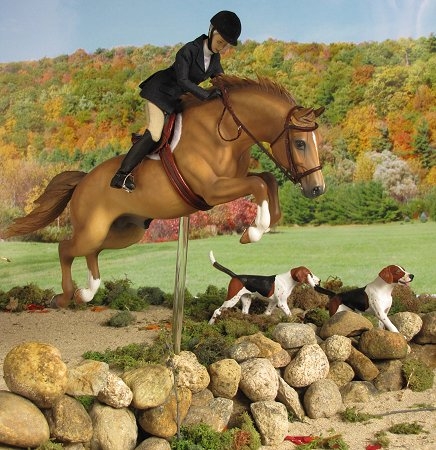
Aer Charmed Life shown as a Chestnut Hanoverian Stallion and is a CM Breyer Jumper by Jen Read. Shown by Andrea Robbins with the comments: FOX HUNTING: Participating in a Fox Hunt while using Side saddle equipment.

Simplee the Last shown as a Chocolate roan/varnish Appaloosa Sporthorse gelding and is a Hot Chic cm’ed and painted by Sherry Clayton. Shown by Robin Nere with the comment: A nice fall day to take the dogs cubbing. (Cubbing – when new or young dogs are taken out for training prior to the formal hunt.).
Doll Rider Correct Seat and Hold the Reins Correctly:

The reins are held between the ring fingers and pinkies with the thumbs solidly on top as they exit the hands. The grip is firm. Close the fingers for optimum communication and safety. Hold the hands just above the horse’s withers, in front of the saddle. Tip the thumbs toward each other at a 45-degree angle. Bend the elbows just enough to create a straight line through the forearms, hands, and reins to the horse’s mouth.
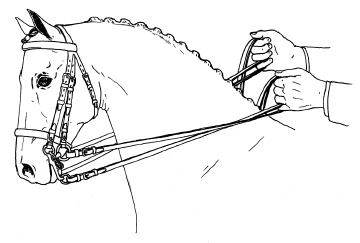
Double Bridle Reins – 2 and 2 Method. Most common handle hold in model horse hobby. It is advised that you put in your comment line what hold your set up is so that judge’s know you understand the three styles on holding the reins.

Double Bridle Reins – 3 in 1 Method. A true challenge for model horse hobbyists and doll rider’s with razor cut slips in the fingers of the hands. Left side curb goes directly back to hand and enters under ring finger with the left snaffle rein coming directly back and entering under the pinky finger with rein crossing over the curb rein. Right side curb rein goes directly back and enters under the middle finger of the left hand with all three reins coming up thru hand and out over the of the index finger with bight cascading down the right side. The right side snaffle goes directly and enters the hand under the ring finger, up into the hand and out over the top of the index finger with the bight draping down the right side. The look gives an ‘X’ to reins the left side of horse’s neck but a two independent rein look to the right side but only one rein going into the right hand. Very tricky set up.
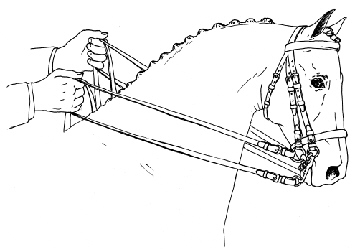
Double Bridle Reins – Fillis Method. The Fillis method of holding the reins is when the curb reins enter the rider’s hand from the bottom, around the little fingers and up to the second joint of the index fingers while the snaffle enters the fist from above over the index fingers. Each hand holds two reins.

